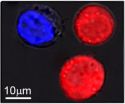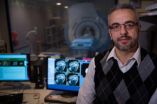(Press-News.org) A scientist at the University of British Columbia and Vancouver Coastal Health has identified the molecule that controls a scissor-like protein responsible for the production of plaques – the telltale sign of Alzheimer's disease (AD).
The molecule, known as GSK3-beta, activates a gene that creates a protein, called BACE1. When BACE1 cuts another protein, called APP, the resulting fragment – known as amyloid beta – forms tiny fibers that clump together into plaques in the brain, eventually killing neural cells.
Using an animal model, Dr. Weihong Song, Canada Research Chair in Alzheimer's Disease and professor of psychiatry, found that disabling GSK3-beta's effect in mice resulted in less BACE1 and far fewer deposits of amyloid in their brains. Song's research, published online today in the Journal of Clinical Investigation, also found that such mice performed better than untreated mice on memory tests.
Previous research had shown that GSK3-beta spurred the growth of twisted fibers inside neurons, known as tangles – another hallmark of AD. Song says his discovery of the protein's dual destructiveness makes it a promising target for drug research.
GSK3-beta, however, is a versatile enzyme that controls many vital physiological functions. The drug used to inhibit GSK3-beta in the mice is too indiscriminate, and could cause several serious side effects, including cancer.
"If we can find a way to stop GSK3-beta's specific reaction with BACE1, and still leave it intact to perform other crucial tasks, we have a much better chance of treating AD and preventing its progression," says Song, a member of the Brain Research Centre at UBC and the Vancouver Coastal Health Research Institute (VCHRI), and Director of the Townsend Family Laboratories at UBC.
### BACKGROUND | Alzheimer's research
An elusive target: Finding AD therapies is particularly challenging because by the time symptoms of memory loss and cognitive decline appear, much of the damage – in the form of plaques and tangles – has already been done and is irreversible. To demonstrate a preventive effect, a new drug would have to be given to a very large group of people, and those people followed over a long period of time to determine if AD rates are lower than a control group.
China connection: Dr. Song conducted some of this research in Chongqing, China, where he is Director of the Canada-China Joint Center for Translational Medical Research in Child Development and Alzheimer's Disease – a partnership between UBC and the Children's Hospital of Chongqing Medical University.
Alzheimer's researcher reveals a protein's dual destructiveness – and therapeutic potential
2012-12-04
ELSE PRESS RELEASES FROM THIS DATE:
Search for life suggests solar systems more habitable than ours
2012-12-04
SAN FRANCISCO—Scattered around the Milky Way are stars that resemble our own sun—but a new study is finding that any planets orbiting those stars may very well be hotter and more dynamic than Earth.
That's because the interiors of any terrestrial planets in these systems are likely warmer than Earth—up to 25 percent warmer, which would make them more geologically active and more likely to retain enough liquid water to support life, at least in its microbial form.
The preliminary finding comes from geologists and astronomers at Ohio State University who have teamed up ...
DNA analysis of microbes in a fracking site yields surprises
2012-12-04
SAN FRANCISCO—Researchers have made a genetic analysis of the microbes living deep inside a deposit of Marcellus Shale at a hydraulic fracturing, or "fracking," site, and uncovered some surprises.
They expected to find many tough microbes suited to extreme environments, such as those that derive from archaea, a domain of single-celled species sometimes found in high-salt environments, volcanoes, or hot springs. Instead, they found very few genetic biomarkers for archaea, and many more for species that derive from bacteria.
They also found that the populations of microbes ...
Multitasking plasmonic nanobubbles kill some cells, modify others
2012-12-04
HOUSTON – (Dec. 3, 2012) – Researchers at Rice University have found a way to kill some diseased cells and treat others in the same sample at the same time. The process activated by a pulse of laser light leaves neighboring healthy cells untouched.
The unique use for tunable plasmonic nanobubbles developed in the Rice lab of Dmitri Lapotko shows promise to replace several difficult processes now used to treat cancer patients, among others, with a fast, simple, multifunctional procedure.
The research is the focus of a paper published online this week by the American ...
Listen up, doc: Empathy raises patients' pain tolerance
2012-12-04
A doctor-patient relationship built on trust and empathy doesn't just put patients at ease – it actually changes the brain's response to stress and increases pain tolerance, according to new findings from a Michigan State University research team.
Medical researchers have shown in recent studies that doctors who listen carefully have happier patients with better health outcomes, but the underlying mechanism was unknown, said Issidoros Sarinopoulos, professor of radiology at MSU.
"This is the first study that has looked at the patient-centered relationship from a neurobiological ...
Women with sleep apnea have higher degree of brain damage than men, UCLA study shows
2012-12-04
Women suffering from sleep apnea have, on the whole, a higher degree of brain damage than men with the disorder, according to a first-of-its-kind study conducted by researchers at the UCLA School of Nursing. The findings are reported in the December issue of the peer-reviewed journal SLEEP.
Obstructive sleep apnea is a serious disorder that occurs when a person's breathing is repeatedly interrupted during sleep, sometimes hundreds of times. Each time, the oxygen level in the blood drops, eventually resulting in damage to many cells in the body. If left untreated, it ...
Mercury releases contaminate ocean fish: Dartmouth-led effort publishes major findings
2012-12-04
In new research published in a special issue of the journal Environmental Health Perspectives and in "Sources to Seafood: Mercury Pollution in the Marine Environment"— a companion report by the Dartmouth-led Coastal and Marine Mercury Ecosystem Research Collaborative (C-MERC), scientists report that mercury released into the air and then deposited into oceans contaminates seafood commonly eaten by people in the U.S. and globally.
Over the past century, mercury pollution in the surface ocean has more than doubled, as a result of past and present human activities such ...
Baby's health is tied to mother's value for family
2012-12-04
The value that an expectant mother places on family—regardless of the reality of her own family situation—predicts the birthweight of her baby and whether the child will develop asthma symptoms three years later, according to new research from USC.
The findings suggest that one's culture is a resource that can provide tangible physical health benefits.
"We know that social support has profound health implications; yet, in this case, this is more a story of beliefs than of actual family support," said Cleopatra Abdou, assistant professor at the USC Davis School of Gerontology.
Abdou ...
University of Minnesota researchers find new target for Alzheimer's drug development
2012-12-04
MINNEAPOLIS/ST. PAUL (December 3, 2012) – Researchers at the University of Minnesota's Center for Drug Design have developed a synthetic compound that, in a mouse model, successfully prevents the neurodegeneration associated with Alzheimer's disease.
In the pre-clinical study, researchers Robert Vince, Ph.D.; Swati More, Ph.D.; and Ashish Vartak, Ph.D., of the University's Center for Drug Design, found evidence that a lab-made compound known as psi-GSH enables the brain to use its own protective enzyme system, called glyoxalase, against the Alzheimer's disease process. ...
Western University researchers make breakthrough in arthritis research
2012-12-04
Researchers at Western University have made a breakthrough that could lead to a better understanding of a common form of arthritis that, until now, has eluded scientists.
According to The Arthritis Society, the second most common form of arthritis after osteoarthritis is "diffuse idiopathic skeletal hyperostosis" or DISH. It affects between six and 12 percent of North Americans, usually people older than 50. DISH is classified as a form of degenerative arthritis and is characterized by the formation of excessive mineral deposits along the sides of the vertebrae in the ...
New Jamaica butterfly species emphasizes need for biodiversity research
2012-12-04
GAINESVILLE, Fla. — University of Florida scientists have co-authored a study describing a new Lepidoptera species found in Jamaica's last remaining wilderness.
Belonging to the family of skipper butterflies, the new genus and species is the first butterfly discovered in Jamaica since 1995. Scientists hope the native butterfly will encourage conservation of the country's last wilderness where it was discovered: the Cockpit Country. The study appearing in today's Tropical Lepidoptera Research, a bi-annual print journal, underscores the need for further biodiversity research ...



